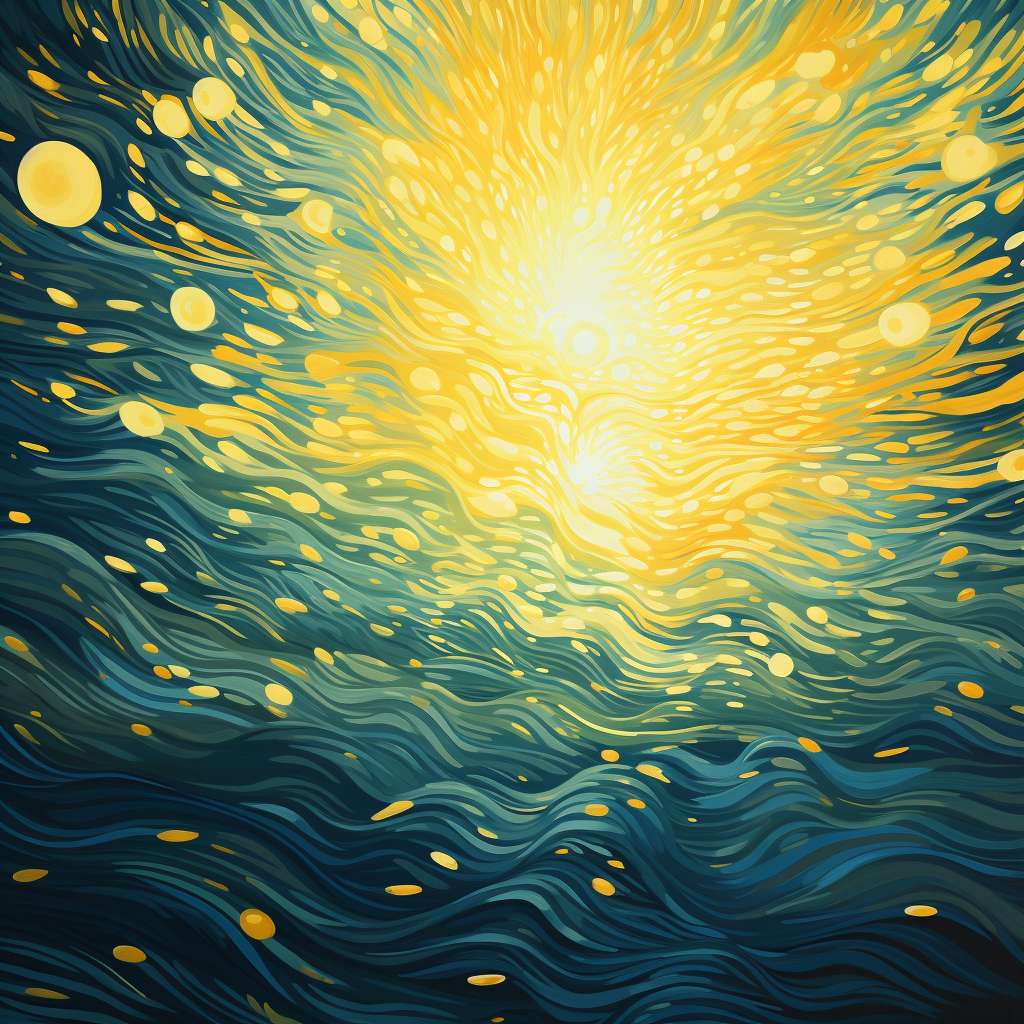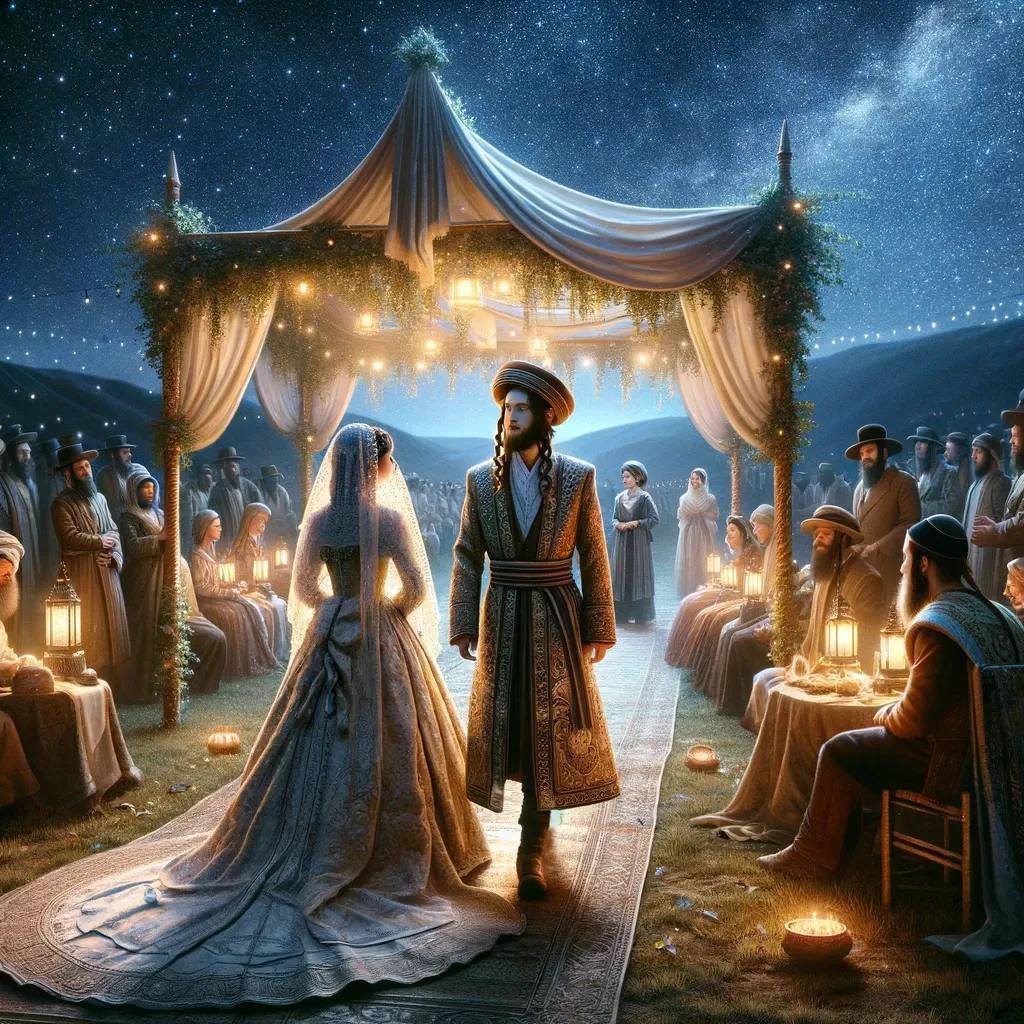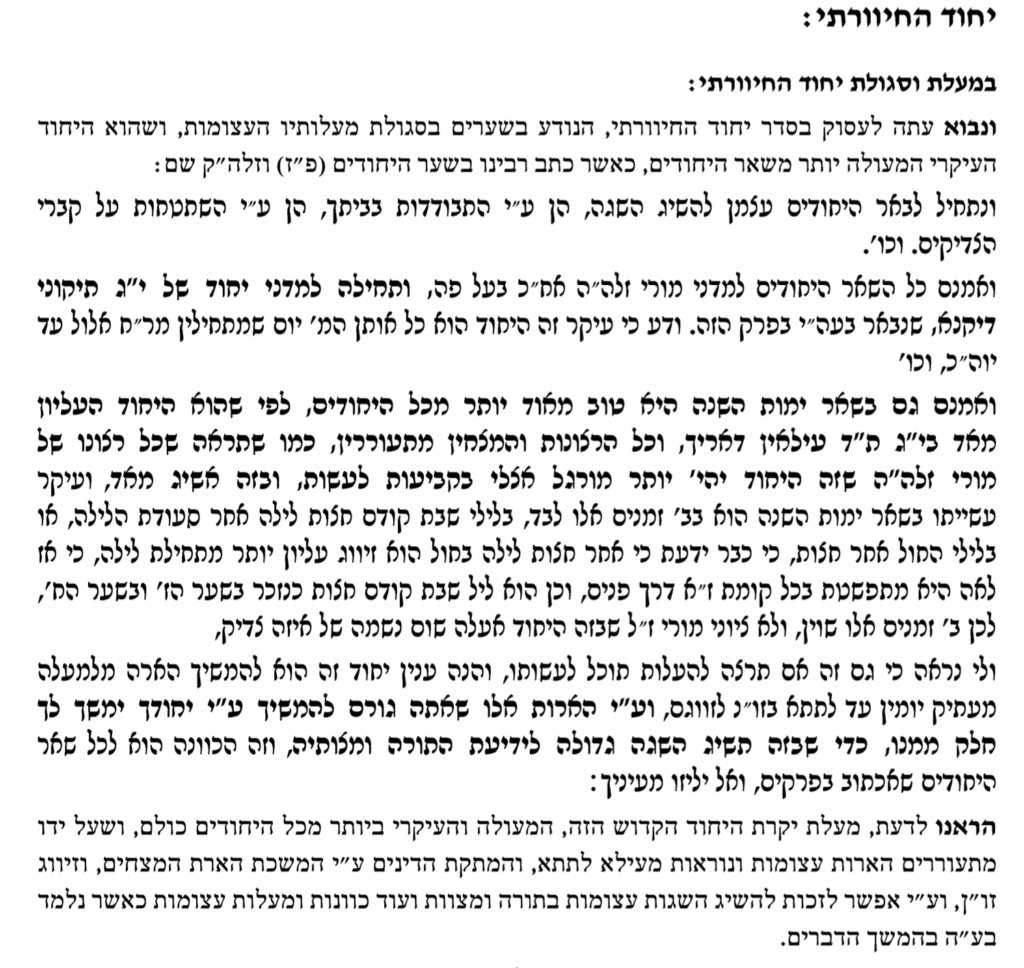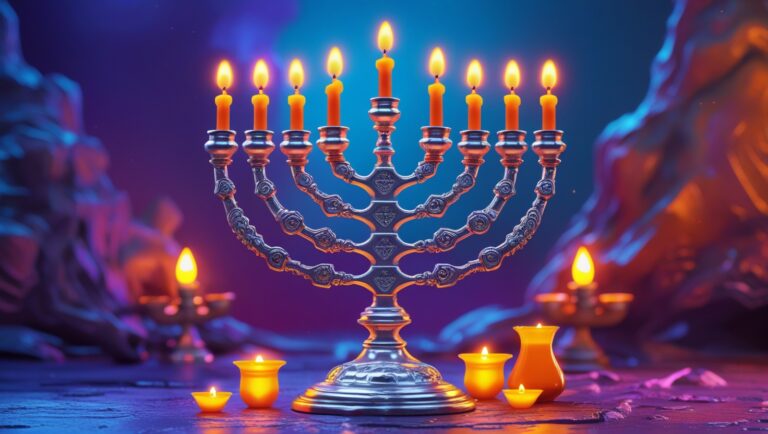Arich Anpin, “The Long Face,” is the highest of the revealed Partzufim (Divine Configurations) in all works of Kabbalah
Often associated with the Sephira of Keter, Arich Anpin is characterized as “pure compassion” since the dinim are subsumed and invisible within it. This spiritual system is described in the Zohar as encompassing all of the other Partzufim Atzilut which vest themselves on it.
To recap: when we speak about these “spiritual configurations”, we are referring to Hashem’s Middot (traits) as He reveals them to us. There is no physicality in the upper worlds and all terms used to describe these systems are merely a way of “pleasing the ear” so we can understand Him.
Therefore, Arich Anpin is the system of Middot (character traits) that the Jewish people saw on Har Sinai (Mount Sinai) as Hashem revealed Himself as an “elder sage” teaching Torah to them. This is in contrast to Zeir Anpin (the “short face”, a “young warrior”) that they saw in the splitting of the Red Sea, meting judgment to th Egyptians.
However, one should never make the mistake that there is any separation between them, rather these are only different ways the One God manifests. This is the error the Israelites did when they asked “Is Hashem with us or not”. The word for “not” (אין) “ayin” is a reference to Arich Anpin, while Hashem is a reference to Zeir Anpin. The Zohar writes that the Israelites asked defiantly and made a separation between the two, which caused Amalek (Gematria = Safek [doubt]) to come and wage war against them.

The Ramchal on Arich Anpin
The Ramchal synthesizes earlier teachings in works like Kelah Pithei Chochmah and Da’at Tevunot.
- Kelah Pithei Chochmah, Pitach 30-35:
- The Ramchal describes Arich Anpin as the supreme configuration of Keter, where all contradictions and difficulties are resolved.
- Da’at Tevunot (The Knowing Heart):
- The Ramchal explains that Arich Anpin represents Hashem’s patience and long-suffering (erech apayim), where divine judgment is withheld to allow for rectification.
- The unity of opposites in Arich Anpin is a recurring theme, showing how mercy tempers strict justice.
- Adir Bamarom (The Mighty One on High):
- This work provides a philosophical and mystical framework for understanding the Partzufim. The Ramchal highlights the 13 Attributes of Mercy as the central function of Arich Anpin, linking it to the divine governance of the spiritual worlds.
The description of Arich Anpin comes from the Idra Rabbah, which is found in the Zohar, Parashat Naso (Zohar III, 127b–145a). This Partzuf is unique in that it possesses white hairs, white eyes, and white beard with its 13 attributes of mercy along with its 7 Tikkunim of the Cranium. He is like a true elder sage, about whom it is said “never slumbers and never sleeps” (Tehilim 121:4).
Arich Anpin is however the external manifestation of “Keter”, the internal is called Atik Yomin and is not revealed.
The Zohar writes that were it not for the fact that Arich Anpin never sleeps, but is continuously irradiating compassion below, the world would’ve been destroyed in an instant. However, as great as His awesome radiance is, for the most part it is also hidden from us.
The 12 Partzufim of Atzilut
In Etz Chaim, Sha’ar Arich Anpin, Chapters 2-3, the Arizal explains that following the process of rectification (Tikkun), after the lights flowed to the Kings of Tohu who died, their rectification was completed by the 10 Sefirot of MaH and the 9 Sefirot of BaN. This created the new structure of the World of Atzilut, consisting of 12 Partzufim, each receiving aspects of MaH and BaN.
The 12 main Partzufim of Atzilut are:
- Atik Yomin (internal Keter – masculine)
- Nukva of Atik (internal Keter – feminine)
- Arich Anpin (external Keter – masculine)
- Nukva of Arich (external Keter – feminine)
- Abba Ila’a (Upper Chokhmah – masculine)
- Imma Ila’a (Upper Binah – feminine)
- Yisrael Saba (Lower Chokhmah – masculine)
- Tevunah (Lower Binah – feminine)
- Israel (Zeir Anpin – Chesed, Gevurah, Tiferet, Netzach, Hod and Yesod – masculine)
- Leah (formed by NAHY of Binah – feminine)
- Yaakov (Upper Malkhut – masculine)
- Rachel (Lower Malkhut – feminine)
It’s important to keep in mind that the order of the Partzufim sometimes change depending on the case at hand but we won’t delve into it. For example, sometimes the entire Chokhmah is divided as Abba Ilaa and Imma Ilaa, sometimes it’s as presented on the list, with Yisrael Saba.
The initial revelation of the Infinite Light (Or Ein Sof) in the World of Atzilut after this rectification occurred through the Partzuf of Atik Yomin. In Atik Yomin, all the 10 Sefirot remain concealed (ne’elamot), and its three upper Sefirot (Gimel Rishin) are so exalted that they have no form of garments (levushim) due to their immense spiritual elevation. These are referred to as the “Unknowable Head” (Reisha D’Lo Ityada), as they are completely beyond human comprehension. In contrast, the seven lower Sefirot of Atik do have garments and are enclothed within the 10 Sefirot of Arich Anpin.
Thus, all 10 Sefirot of Atik Yomin are considered, relative to the rest of the Partzufim, to be the “Keter” (Crown) of the original, essential, and foundational 10 Sefirot of the World of Atzilut. It’s important to remember that Keter did not die like the 7 primordial Sephirot, not fell down like Chokhmah and Binah, but was merely blemished.
Therefore our main efforts in Avodat Hashem are geared towards bringing the Tikkun to Zeir Anpin and Nukvah (the Malkhut or Shekhina), who “died” and their sparks and vessels fell down to Beriyah, Yetzirah and Assiyah. While there is some Tikkun to Arich Anpin we perform tangentially, it is mostly rectified already.
I like to compare all these Partzufim to the archetypes of spiritual ascent that a person goes through in this world. The Arizal very fittingly teaches that a man should consider himself as if he is (i.e. follows the patterns of) Zeir Anpin. The man is separated from his wife (Malkhut, the Shekhina) and must unite with her, as it happens to these Partzufim in the spiritual worlds. This union is not constant and in this state both require a lot of spiritual work.
When they become parents, they rise to the level of Abba and Imma and are, in the Zohar’s language, “always together” in relation to their children who are now Zeir Anpin and Nukvah themselves. This union between Abba and Imma is constant as they appear to their children as the parents must display peace and a state of union in their decision making. There are still dinim (judgments) here however since they are not complete.
Once they rise even more, have grandchildren and grow in wisdom and character traits, the parents become grandparents and follow the pattern of Arich Anpin and Nukvah of Arich Anpin. Here they have arrived at the pinnacle of righteousness, patience, compassion and wisdom (in an ideal sense). We see that Tzadikim have white hair, only seek good, and are almost completely devoid of desire for this lower world. There should be no difference between the man and the woman on an intellectual level, as they have now merged into one soul (the Zohar writes that one cannot see division between them at this level).
This is the ultimate union to strive for in life.

The Tikkunim of Arich Anpin
Following the chain of descent (Seder Hishtalshelut) of the Infinite Light after Atik Yomin, the Partzuf of Arich Anpin emerges. Its nine lower Sefirot (Tesha Sefirot Elyonot) are considered the foundational and essential Sefirot of the World of Atzilut. However, only the Keter and Chochmah of Arich Anpin are referred to as Rishin (Heads) because they are located in the “head” (Risha) of Arich Anpin.
In this Partzuf, the Keter is the “skull”, while the Chokhmah (also called Mocha Setima’ah) is inside of it and fills it. Binah of Arich Anpin descends to the throat, and the Da’at of Arich Anpin descends to between the two shoulders. This is in contrast with Zeir Anpin, who has Chokhmah, Binah and Da’at inside the head.
It turns out, therefore, that in the head of Arich Anpin (Risha D’Arich Anpin), there are two heads: the Keter and Chochmah of Arich Anpin. However, between these two heads, there is an additional “head” known as Avirah, which is the subtle light (Mochin Zachin) that resides within the Gulgalta (Cranium). After Avirah, there is a membrane (Kruma) that separates this light from the next head, Mochah Setima’ah (the Chokhmah).
This is all important to know because, in the Yihud (unification) we will learn below, there are 3 main emanations of the “beard” of Arich Anpin called Hivartei, Nimin and Tikkunei Diknah.
Each of them come from one of the heads.
The 3 emanations of the beard
1. Hivartei (Whiteness) in Etz Chaim
The Hivartei of Arich Anpin is the highest of the emanations of the beard of Arich Anpin, associated with the purity and mercy of the Gulgalta (Cranium). Whiteness symbolizes unblemished mercy and infinite light, which flows directly from Keter.
Primary Sources:
- Etz Chaim, Sha’ar Arich Anpin, Chapter 4:
“The whiteness of the Gulgalta signifies the purity of Keter. It is from this whiteness that the 370 lights of divine mercy emanate (given by the 2 miluyim of the name El (אלף למד = 185). The light is so pure and unblemished that it transcends all judgment.” - Etz Chaim, Sha’ar HaGilgulim, Introduction 31:
“Hivartei represents the essence of mercy that permeates all the attributes of Arich Anpin. It is a light so infinite that it is described as ‘above grasp.’ This is why the Gulgalta is called ‘white and pure.'”
Zohar Connection:
- Zohar Idra Rabba, Zohar III, 136b:
“The cranium of Arich Anpin is pure white. From this whiteness flows the essence of divine compassion, which permeates the universe and rectifies the vessels of all the worlds.”
2. Nimin (Hairs) in Etz Chaim
The Nimin (hairs) of Arich Anpin are described as refined strands of light emanating from the cranium (Gulgalta). The Arizal explains that these hairs represent pathways for the diffusion of divine energy in a bundled form. Their source is in the Avira.
Primary Sources:
- Etz Chaim, Sha’ar Arich Anpin, Chapter 5:
“The hairs of Arich Anpin are thin, straight, and white, representing channels of light that emanate from the Gulgalta. These hairs are pathways for divine energy, but their refinement ensures that the light is not overwhelming for the vessels below. - Etz Chaim, Sha’ar Klallim, Section 4:
Each strand of hair is a narrow conduit for energy. It represents the process of tzimtzum (constriction) and the diffusion of infinite light into finite pathways, making it receivable for the lower worlds.”
Zohar Connection:
- Zohar Idra Rabba, Zohar III, 136b-137a:
“From the Gulgalta come hairs, numbering infinite strands, which extend as pathways of mercy and light to the lower worlds. These hairs are delicate and pure, carrying the refinement of the supernal light.”
3. Tikkuney Dikna (Beard) in Etz Chaim
The Dikna is discussed in detail in the context of Arich Anpin in Etz Chaim. The Arizal elaborates on the 13 Rectifications of the Beard, which correspond to the 13 Attributes of Mercy (Yud Gimel Middot HaRachamim) and they originate in the Mocha Setima’a (the Chokhmah)
Primary Sources:
- Etz Chaim, Sha’ar Arich Anpin, Chapter 6:
“The 13 strands of the beard emanate from the Gulgalta (Cranium) of Arich Anpin. These are the channels of mercy, known as the Yud Gimel Tikkunei Dikna, and are derived from the supernal white radiance. They mitigate all forms of harsh judgment in the worlds below.” - Etz Chaim, Sha’ar Ma’amarei Rashbi (Commentary on Idra Rabba):
“The 13 strands extend mercy into the world. The first strand emerges from the upper lip and is called ‘Rachamim.’ These strands are also associated with the rectification of Gevurah and Din (judgment).”
Zohar Connection:
- Zohar Idra Rabba, Zohar III, 136b-138b:
The Dikna, comprised of 13 rectifications, flows from the Gulgalta and descends into the worlds, softening the harsh judgments of Gevurah and illuminating them with Chesed.”
Summary of the Three Emanations
| Emanation | Meaning | Function | Symbolism | Source |
|---|---|---|---|---|
| Hivartei | Purity of the cranium | Infinite mercy and pure divine light | Unblemished grace and transcendence | Etz Chaim Sha’ar Arich Anpin 4, Zohar III 136b |
| Nimin (Hairs) | Fine strands of hair | Constrict and diffuse light into receivable pathways | Individual channels of mercy | Etz Chaim Sha’ar Arich Anpin 5, Zohar III 136b-137a |
| Dikna (Beard) | 13 strands of the beard | Channel mercy through the 13 Attributes of Mercy | Sweetening of judgments (Din) | Etz Chaim Sha’ar Arich Anpin 6, Zohar III 136b-138b |
Yichud HaHivartei in Sha’ar Ruach HaKodesh
The “Yichud HaHivartei” (the unification of whiteness) is arguably the highest of them, and is meant to draw down light from these immense lights. In the writings of Rabbi Chaim Vital, the student of the Ari, and particularly in Sha’ar Ruach HaKodesh, this unification involves drawing down light from the Hivartei into the Nimin and into the Tikkuney Dikna.
These rectifications act as conduits for divine light, descending “drop by drop” through metaphysical pathways symbolized by the hairs of the beard.
During moments of grace (Et Ratzon), such as the month of Elul, after Chatzot Layla (midnight), after Mincha of Shabbat, or during festivals, Arich Anpin is revealed to shine divine mercy upon Creation. According to the Arizal, these are the choicest times for performing the Yichud HaHivartei.
The Rashash (R’ Shalom Sharabi) goes further and says you should do this Yichud anytime (and this is the halacha). Presumably, the more the better for Creation, so let’s get learning.
First, if you are a man make sure you immersed in the Mikvah to get rid of the Tumat Keri and don’t perform this Yichud in filthy places or in the presence of immodest sights. I don’t need to tell you to be makpid and follow all Halacha to the best of your ability. Seek purity and holiness always.
The Yichud begins by meditating upon 3 names of ע״ב of the Hivartei which give their Yodin (י) to the Nimim, and the Vavin (ו) to the Tikkuney Dikna. Remember that the second line of each of them is the 13th attribute, which is the klalut of all. The 3 names of קס״א are the garments of these lights.


Once you have this clear, we bring now the Nekudot as follows using the Dalets to the Nimin and the Hehs to the Tikkuney Dikna (of the name ע״ב). Again, Hivartei > Nimin and then Hivartei > Tikkunei Dikna.
Now comes the cantillation marks:
There is now a continuation of the Yichud with an explanation by the Arizal of how the lights of Atik Yomin vest themselves in the head of Arich Anpin. You will bring down a great light from Netzach, Hod, Yesod and Malkhut of Atik Yomin and unify the Nimin and Tikkunei Dikna.
This is followed by a Tefilah that Hashem should pour down his compassion upon all of Creation.
Note: The 3 names of angels Chokhmiel, Shimshiel and Azriel should not be pronounced but only intended.
Next we bring down the light from Binah of Atik Yomin to the forehead of Arich Anpin, to the forehead of Abba and Imma, and to the forehead of Zeir Anpin. This symbolized by the names אהיה for the first 3 and יהוה for Zeir Anpin.
No need to rush, take your time.
This is all followed by a short Tefilah and the union between Zeir Anpin and Nukvah.
Final thoughts
There is much more to explore on this Yichud. Even if one can’t get everything right, I believe there’s immense value in trying, and with a straight and honest heart, Hashem should consider as if we did everything perfectly.
One final tip which I think is crucial is that whatever spiritual work you are doing, the effect is cumulative. The Arizal exhorted Rabbi Chaim Vital to be very rigorous on performing Yichudim everyday, as they are higher than even Torah study (though it does not exempt it).
May your meditations seed above and bring the fruits below!







